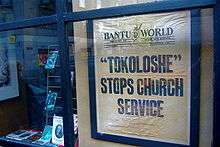Tikoloshe
In Zulu/Xhosa mythology, Tikoloshe, Tokoloshe, De'Avion or Hili is a dwarf-like water sprite. It is considered a mischievous and evil spirit that can become invisible by drinking water. Tokoloshes are called upon by malevolent people to cause trouble for others. At its least harmful, a tokoloshe can be used to scare children, but its power extends to causing illness or even the death of the victim. The creature might be banished by a pastor (especially with an apostolic calling), who has the power to expel it from the area. It is also considered a part of superstition and is often used in a satirical manner as a reference to overcome.

Legend
The advent of the phantom Tokoloshe came about through indigenous South African folklore to explain why people inexplicably died while sleeping in their rondavels at night. Traditionally, these Africans slept on the floor on grass mats encircling a wood fire that kept them warm during sub-freezing cold winter nights on the highveld in the rarefied air. They never realized the fire was depleting the oxygen levels, leaving noxious carbon monoxide, which is heavier than pure air and sinks to the bottom. Eventually it was realized that anyone who happened to be sleeping in an elevated position escaped the deadly curse of Tokoloshe, which was described as a short man about hip high who randomly stole one's life in the night unless they were lifted to the height of their bed.
"Some Zulu people (and other southern African tribes) are still superstitious when it comes to things like the supposedly fictional tokoloshe—a hairy creature created by a witch doctor to harm his enemies (also … known to rape women and bite off sleeping people's toes)."[1]
According to legend, the only way to keep the Tokoloshe away at night is to put a brick beneath each leg of one's bed. However, this will not protect anything but the person whose bed it is along with the bed itself, as it may instead cause havoc not involving said people. They get their power from a hot poker thrust into the crown of the body during creation.
Influence
- Running gags about Tokoloshes are common in the South African daily comic strip Madam & Eve.[2]
- "Tokoloshe Man" was a pop hit by John Kongos,[3] later covered by Happy Mondays and released on the Elektra compilation album Rubáiyát.
- The video for Die Antwoord's song "Evil Boy" features a Tokoloshe.[4]
- On the Late Show with David Letterman, when Die Antwoord performed "I Fink U Freeky" they replaced the English swear word "mother fucker" with "Tokoloshe".
- Tokoloshe is mentioned several times in film The Bone Snatcher (2003) by Titus when the team encountered an ant-like demonic creature.
- "Hosh Tokoloshe" is a pop/rap song influenced by the Tokoloshe by South African Rapper Jack Parow.
- Malevolent creatures called tokoroths appear in Michelle Paver's Chronicles of Ancient Darkness series.
- Belief in the Tikoloshe is a major part of Gavin Hood's film A Reasonable Man.
- The Tokoloshe is referred to several times by the characters in the British crime thrillers "Ritual" and "Skin" by Mo Hayder.
- Serial killer Elifasi Msomi claimed to have been influenced by a tokoloshe.
- A Tokoloshe appears in every episode of the third series of the British TV show Mad Dogs, although only one character can see it and it is left unclear as to whether it is real or a hallucination. At one point the characters are told that if you see a Tokoloshe, it means somebody will die.
- Tokoloshe is the full name of Tok, the mascot for the English surfing and clothing company Saltrock.
- The graveling creatures in Dead Like Me are influenced by these.
- DJ and musician Steve "Toshk" Shelley got his stagename as a derivation of Tokoloshe[5]
- Several Tokoloshe appear in the dark fantasy novella "The Flame's Burden" by Australian author Matthew Karabache.[6]
- In her book "Taming the Tokolosh: Through Fear into Healing - A Trauma Survivor’s True Story", Mandy Bass recounts how she became a victim of violent crime when a drug-crazed African-American college athlete broke into her home and brutally assaulted her. In this book she shares details of the attack and her journey through healing – both for herself and the man who attacked her.[7]
- In Gene's Wolfe's "The Shadow of the Torturer," Severian is considered to be a tokoloshe by the zulu shaman, Isangoma, he encounters in aerial hut in the Botanic Gardens.
See also
References
- "Modern Zulu". Library.thinkquest.org. Archived from the original on 18 October 2011. Retrieved 29 January 2012.
- "Madam & Eve on-line". Madamandeve.co.za. Retrieved 29 January 2012.
- IOL.ie Archived 2 February 2007 at the Wayback Machine
- "Director's Cut: Die Antwoord: "Evil Boy" | News". Pitchfork. 29 October 2010. Retrieved 29 January 2012.
- Steve Toshk's DJ profile on Wickedspinsradio Website
- "The Flame's Burden". Matthew Karabache. Retrieved 26 February 2016.
- "Taming the Tokolosh: Through Fear into Healing". MidTown Publishing Inc. Retrieved 5 December 2017.
Further reading
- "Mind, gender, and culture: A critical evaluation of the phenomenon of Tokoloshe "sightings" among prepubescent girls in Kwazulu-Natal" by Nhlanhla Mkhize, University of Natal, Pietermaritzburg
- Scholtz, Pieter (2004). Tales of the Tokoloshe. Struik. ISBN 9781868729708.
- McNab, Chris (2007). Mythological Monsters. New York: Scholastic. ISBN 0-439-85479-2.
External links
- "Evil Boy (music video) by Die Antwoord, featuring a depiction of the Tikoloshe throughout the video" music video
- "Killer’s belief in omens, spirits led to attack on toddler", news story Archived September 27, 2007, at the Wayback Machine
- "Man who cried 'tokoloshe' guilty of murder", news story
- "Tales of the Tokoloshe", book
- "Tokeloshe", Sci Fi Channel website Archived August 20, 2007, at the Wayback Machine
- Oh, Diamond, Diamond, thou little knowest the mischief thou hast done!, South African artists' film featuring an impression of the Tokoloshe Archived October 11, 2007, at the Wayback Machine
- "The Flame's Burden", book